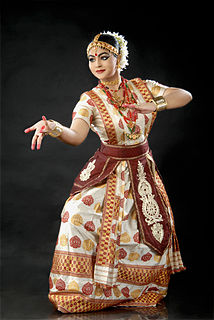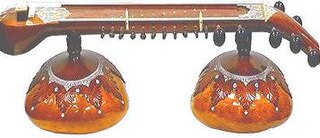Śārṅgadeva (1175–1247) (शार्ङ्गदेव), [1] also spelled Sharngadeva or Sarnga Deva, was the 13th-century Indian musicologist who authored Sangita Ratnakara – the classical Sanskrit text on music and drama. [2] It is considered to be the authoritative treatise in Indian classical music by both the Hindustani music and the Carnatic music traditions. [3] [4]

India, also known as the Republic of India, is a country in South Asia. It is the seventh largest country by area and with more than 1.3 billion people, it is the second most populous country and the most populous democracy in the world. Bounded by the Indian Ocean on the south, the Arabian Sea on the southwest, and the Bay of Bengal on the southeast, it shares land borders with Pakistan to the west; China, Nepal, and Bhutan to the northeast; and Bangladesh and Myanmar to the east. In the Indian Ocean, India is in the vicinity of Sri Lanka and the Maldives, while its Andaman and Nicobar Islands share a maritime border with Thailand and Indonesia.

The Sangita-Ratnakara, सङ्गीतरत्नाकर,, literally "Ocean of Music and Dance", is one of the most important Sanskrit musicological texts from India. Composed by Śārṅgadeva (शार्ङ्गदेव) in the 13th century, both Hindustani music and Carnatic music traditions of Indian classical music regard it as a definitive text. The author was a part of the court of King Singhana II (1210–1247) of the Yādava dynasty whose capital was Devagiri, Maharashtra.

Indian classical music is the classical music of the Indian subcontinent. It has two major traditions: the North Indian classical music tradition is called Hindustani, while the South Indian expression is called Carnatic. These traditions were not distinct till about the 16th century. There on, during the turmoils of Islamic rule period of the Indian subcontinent, the traditions separated and evolved into distinct forms. Hindustani music emphasizes improvisation and exploring all aspects of a raga, while Carnatic performances tend to be short and composition-based. However, the two systems continue to have more common features than differences.
Contents
Śārṅgadeva was born in a Brahmin family of Kashmir. [5] In an era of Islamic invasion of the northwest regions of the Indian subcontinent and the start of Delhi Sultanate, his family migrated south and settled in the Hindu kingdom in the Deccan region ruled by the Yadava dynasty near Ellora Caves (Maharashtra). Sarangadeva worked as an accountant with freedom to pursue his music interests in the court of King Singhana II (1210–1247). [5] [6] [7]

Brahmin is a varna (class) in Hinduism specialising as priests, teachers (acharya) and protectors of sacred learning across generations.

Kashmir is the northernmost geographical region of the Indian subcontinent. Until the mid-19th century, the term "Kashmir" denoted only the Kashmir Valley between the Great Himalayas and the Pir Panjal Range. Today, it denotes a larger area that includes the Indian-administered territory of Jammu and Kashmir, the Pakistani-administered territories of Azad Kashmir and Gilgit-Baltistan, and Chinese-administered territories of Aksai Chin and the Trans-Karakoram Tract.

The Indian subcontinent is a southern region and peninsula of Asia, mostly situated on the Indian Plate and projecting southwards into the Indian Ocean from the Himalayas. Geologically, the Indian subcontinent is related to the land mass that rifted from Gondwana and merged with the Eurasian plate nearly 55 million years ago. Geographically, it is the peninsular region in south-central Asia delineated by the Himalayas in the north, the Hindu Kush in the west, and the Arakanese in the east. Politically, the Indian subcontinent includes Bangladesh, Bhutan, India, Maldives, Nepal, Pakistan and Sri Lanka.











